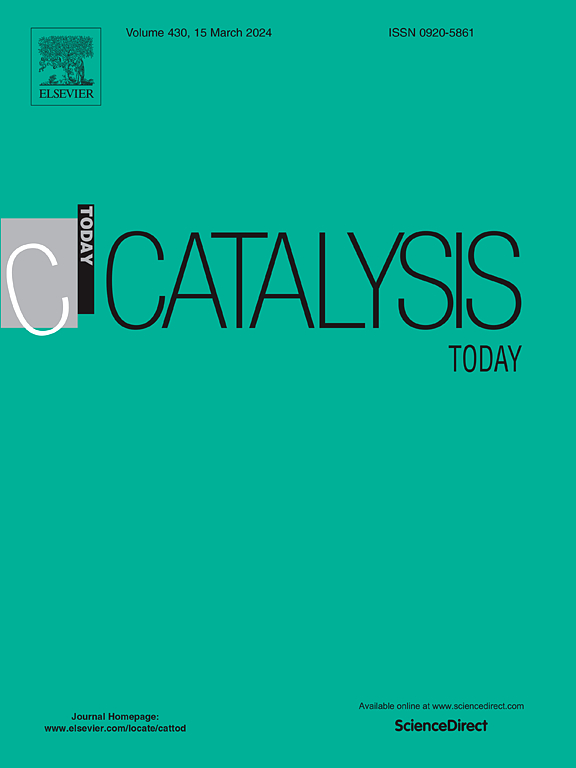Effects of defective nanostructured alumina supports on the syngas production by tri-reforming of methane
IF 5.2
2区 化学
Q1 CHEMISTRY, APPLIED
引用次数: 0
Abstract
This work aims to evaluate the influence of defective nanostructured alumina supports on the catalytic performance of the solids in the TRM reaction. The synergistic effects between NiPt nanoparticles on the nanostructured alumina support is also examined. Depending on the promoter added to the nanostructured alumina i.e., Zn, Mg or La, stable spinel phases or solid solutions with abundant intrinsic oxygen defects are formed. For NiPt/Al2ZnxOy and NiPt/Al2LaxOy, enriched PtOx and NiO nanoparticles microenvironments surrounding the defective support facilitate oxygen diffusion within the crystal lattice to the NiPt surface, which appeared to be the reason for the activity of the solids in the reaction. The NiPt/Al2MgxOy formed a NiO-MgO solid solution and out layer spinel phases, in which the presence of lattice oxygen species and extended defects helped by the accessible NiPt alloy on the support surface gave a strong metal-support interaction. This results in an improvement of the methane and CO2 conversions of 75 and 95 % at H2/CO ratio of 1.3.
缺陷纳米氧化铝载体对甲烷三重整制合成气的影响
这项工作旨在评估缺陷纳米结构氧化铝载体对固体在TRM反应中的催化性能的影响。研究了NiPt纳米颗粒对纳米结构氧化铝载体的协同作用。根据在纳米氧化铝中添加的促进剂,即Zn、Mg或La,可以形成稳定的尖晶石相或具有丰富的固有氧缺陷的固溶体。对于NiPt/Al2ZnxOy和NiPt/Al2LaxOy,缺陷载体周围富集的PtOx和NiO纳米颗粒微环境有利于氧在晶格内扩散到NiPt表面,这似乎是反应中固体活性的原因。NiPt/Al2MgxOy形成了NiO-MgO固溶体和外层尖晶石相,其中晶格氧的存在和NiPt合金在支撑表面可触及的扩展缺陷的帮助下产生了强烈的金属-支撑相互作用。在H2/CO比为1.3时,甲烷和二氧化碳的转化率分别提高了75%和95% %。
本文章由计算机程序翻译,如有差异,请以英文原文为准。
求助全文
约1分钟内获得全文
求助全文
来源期刊

Catalysis Today
化学-工程:化工
CiteScore
11.50
自引率
3.80%
发文量
573
审稿时长
2.9 months
期刊介绍:
Catalysis Today focuses on the rapid publication of original invited papers devoted to currently important topics in catalysis and related subjects. The journal only publishes special issues (Proposing a Catalysis Today Special Issue), each of which is supervised by Guest Editors who recruit individual papers and oversee the peer review process. Catalysis Today offers researchers in the field of catalysis in-depth overviews of topical issues.
Both fundamental and applied aspects of catalysis are covered. Subjects such as catalysis of immobilized organometallic and biocatalytic systems are welcome. Subjects related to catalysis such as experimental techniques, adsorption, process technology, synthesis, in situ characterization, computational, theoretical modeling, imaging and others are included if there is a clear relationship to catalysis.
 求助内容:
求助内容: 应助结果提醒方式:
应助结果提醒方式:


